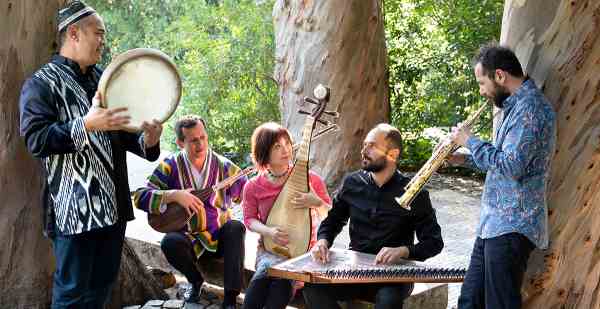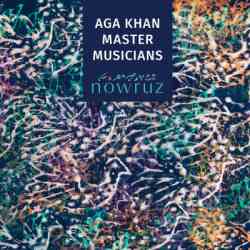

The Aga Khan Master Musicians
Each of the six musicians playing have contributed at least one composition to the album, either played solo, as in the case of Jasser Haj Joussef's " Cadenc"e performed on the viola d'amore, or anything upwards of that. Nevertheless, despite the individuality of the players involved there is a homogeneity of approach which brings a unity to the whole proceedings. This stems largely from them having played together over a period of several years, their Aga Khan Master Musicians Programme, which incorporates a good deal of education work, having started in 2013. This singularity of approach has also grown from a wish within the project to promote the Islamic traditions of music, so for cultural and historical reasons there is a stylistic thread running through these traditions and through the music to be heard here.
The instruments played on Nowruz are varied, but there are also common links to be found between them. The qanun, a trapezoid zither played by Feras Charestan has its roots in ancient Mesopotamia but it exists today in different forms across the Middle East. The pipa, played by Wu Man is associated with China but is nevertheless thought to have its origins in Central Asia and is related to lutes from that region. Both musicians can be heard on Wu Man's composition “Teahouse” with percussionist Abbos Kosimov playing the riq, a type of tambourine. Sirojiddin Juraev plays another type of two-stringed lute, the dutar. On his own composition “Mehan,” he plays in a duet with Kosimov, who is first heard on the chang cabuz, a kind of jaws harp, before transferring to the doira, a frame drum, the 7/8 rhythm reflecting the music style of Juraev's Tajik tradition.
The two instruments played on the album which have more connection with western music are the viola d'amore and the saxophone. Yet the former, a baroque instrument which is itself an antecedent of the Norwegian Hardanger fiddle, is believed to originally come from Central Asia while the saxophone, though American in origin, is given a new voice by Basel Rajoub, matching his other chosen instrument for the album, the duclar, a hybrid instrument created by fitting a duduk with a clarinet mouthpiece, as heard on "Madad."
The intricate melodies on Nowruz tend to be played in unison by the partaking musicians which reinforces the sense of musical unity. There is also a fair bit of improvisation, though this tends to feature individuals rather than collaborations, more of which would have been welcome. The recording is first-rate and the playing by these excellent musicians is hard to fault. The change between tracks from ensemble playing to solo or smaller group contributions works well with a density of sound giving way to transparency in this impressive piece of work. Find the Aga Khan program online.
Further reading:
Search RootsWorld
|

 As their name would lead us to expect, The Aga Khan Master Musicians display a high level of musicianship, presenting coherent collaborative performances which belie the fact that they emanate from a range of musical backgrounds, encompassing the Middle East, Central Asia and China. “Tashkent,” the opening track of their debut album Nowruz showcases this admirably, setting the style of what is to come and features all six musicians, something which only happens on four of the twelve tracks. This first piece is composed by reeds player Basel Rajoub who states the melody on saxophone across the percussion and stringed instrumentation of the rest of the ensemble.
As their name would lead us to expect, The Aga Khan Master Musicians display a high level of musicianship, presenting coherent collaborative performances which belie the fact that they emanate from a range of musical backgrounds, encompassing the Middle East, Central Asia and China. “Tashkent,” the opening track of their debut album Nowruz showcases this admirably, setting the style of what is to come and features all six musicians, something which only happens on four of the twelve tracks. This first piece is composed by reeds player Basel Rajoub who states the melody on saxophone across the percussion and stringed instrumentation of the rest of the ensemble.